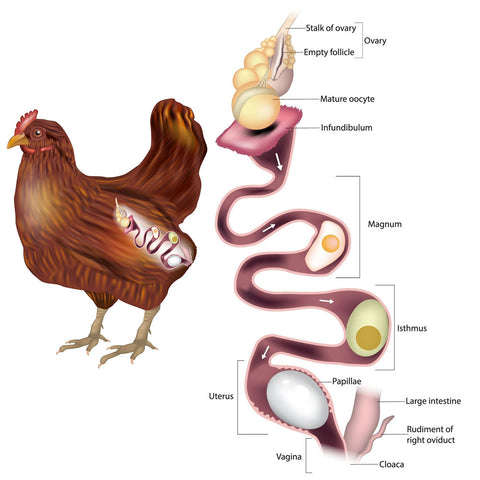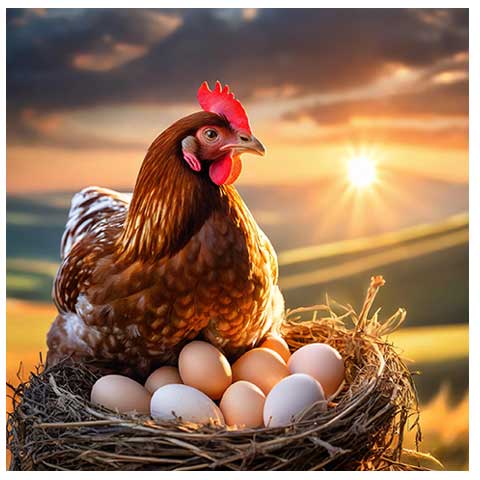Eggs are an incredible source of nutrition and a staple ingredient in many cuisines around the world. But have you ever wondered exactly how a chicken egg is made inside the hen? The process of egg formation is truly fascinating and involves several steps before the egg is ready to be laid. In this article, we’ll walk through the chicken’s reproductive system and the journey an egg takes from ovulation to being laid in the nest.
The Chicken’s Reproductive System
Before diving into egg formation, it’s helpful to understand the basic parts of a laying hen’s reproductive tract
- Ovary: This organ holds immature egg yolks in structures called follicles. The hen has two ovaries, but only the left ovary develops and releases yolks.
- Oviduct A long winding tube where the egg is assembled. It contains different sections
- Infundibulum – Where fertilization happens
- Magnum – Thick albumen (egg white) is added here
- Isthmus – Shell membranes added
- Uterus/shell gland – Egg shell forms here
- Cloaca: The opening where the egg exits the hen’s body
Now let’s look at what happens in each step of egg development inside the oviduct:
Step 1: Ovulation
Egg formation starts when the ovary releases an immature yolk into the oviduct in a process called ovulation. This happens roughly every 25 hours as hormones signal a mature yolk to break free from the ovary.
The yolk is captured by the infundibulum and stays there for about 15 minutes waiting for potential fertilization. However, a rooster is not needed for the rest of egg development.
Step 2: Egg White Forms in Magnum
The yolk next moves to the magnum portion of the oviduct where albumen (egg white) is secreted and layered around the yolk. This takes around 3 hours as alternating thin and thick layers of albumen are deposited.
The albumen contains about 90% water and 10% protein, providing a protective cushion for the developing yolk and embryo (if fertilized).
Step 3: Membranes Added in Isthmus
In the isthmus region, two shell membranes are formed around the albumen in about an hour. The inner and outer membranes help contain the egg contents and also regulate gas/moisture exchange through the shell.
Step 4: Shell Creation in Uterus
The longest stage is forming the egg shell in the uterus, taking 20-21 hours.
Here, calcium from the hen’s medullary bone and dietary calcium are used to create the calcium carbonate shell. Shell color pigments like oocyanin (blue) are also added.
The shell contains about 7,000-17,000 microscopic pores that allow air exchange while still protecting the contents. A final coating called the cuticle or “bloom” is layered over the shell to prevent bacterial invasion.
Step 5: Egg Positioning and Laying
About 24-26 hours after ovulation, contractions of the reproductive tract move the egg into position in the vana with the large end pointing outward.
This presents the fewest nerves during the laying process, making it less painful for the hen.
The cloaca everts and the egg is pushed out slowly over several strained contractions. Finally, the egg arrives warm and wet in the nest!
The hen will then take a brief pause before her body starts preparing the next yolk for release from the ovary, beginning the cycle again.
Key Takeaways on Egg Formation
- An egg takes 24-26 hours to form with 5 main stages: ovulation, albumen deposition, membrane addition, shell creation, and laying
- Only the left ovary matures and releases yolks; the right one regresses
- The oviduct sequentially adds components like albumen, membranes, shell, bloom before laying
- No rooster is needed for a hen to lay eggs, only to fertilize them
- Eggshell color comes from pigments like oocyanin added in the uterus
- The egg exits through the cloaca/vent pointed large end first for easier laying
So next time you crack open an egg, take a moment to appreciate the incredible biology involved in making this perfect protein package! A hen’s reproductive system is amazing in its coordination and efficiency.

How does a Hen make an Egg?
How a hen makes an egg is a remarkable journey showing natures complexity and efficiency, enabling hens to lay eggs almost daily.
So, let me describe how we can travel from egg cell to egg box – in just a day!
The physiology of making an egg involves several biological steps. The entire process from ovulation to laying a shelled egg takes about 24 hours.

It starts with the ovary of course (no input from a male is needed for egg formation to begin).
Hens have two ovaries, but usually only the left one is functional. This ovary contains thousands of ova (egg cells) that can potentially develop into eggs.
When a hen reaches maturity which, depending on breed, can be from 18 to 22 weeks old, hormonal changes trigger the development of an ovum into a yolk.
This yolk is released into the oviduct where the egg will be formed. The oviduct is a long winding tube made up of several sections including the magnum (egg formation), the isthmus (shell membrane added), and the uterus or shell gland where the shell hardens.
As the yolk moves through the oviduct, it is encased in layers of albumen (egg white), which provides protection and nutrients.
Further down the oviduct, membranes form around the albumen and yolk. The egg then reaches the shell gland, where the shell is formed over a period of about 20 hours. The shell is primarily made of a crystalline form of calcium carbonate and is deposited layer by layer around the yolk and albumen.
Plenty of calcium is essential for a hen to produce a nice thick, smooth eggshell. Providing sources of calcium and vitamin D3 in their diet is essential.
Giving hens oystershell and a vitamin tonic will help this, especially during winter months when daylight is limited. Otherwise, if needed, hens could ‘rob’ their skeleton of calcium to ensure robust eggshells, which would be detrimental to her long-term health. See more on calcium and vitamin D in: Solving Problems with Egg Shells.
The shell is soft as the egg travels through the oviduct. As it nears the end of its journey it hardens to make sure it is strong enough to withstand the outside environment.
As the egg leaves the hen’s body through the cloaca, it receives a protective coating, or bloom, to seal the pores against contamination. So, you will find a lovely clean egg laid in the nest.

In female birds, the cloaca is a multi-purpose opening for the expulsion of bodily waste, and it also serves as the exit for laying eggs. Don’t worry though, the hen’s body cleverly expands the oviduct to ‘close’ the waste tube and allow a clean egg to be laid.
After laying an egg, the hen usually has a short rest period before the cycle starts again. Hens, unlike wild birds, are domesticated (farm) birds, bred for egg laying and meat production.
Wild birds, and other non-domesticated birds, however, lay their eggs infrequently. Evolution has tailored them to lay eggs for breeding and in seasons when the environment favours survival of their young.
For more on which breeds of chickens lay the most eggs, what colour shells are produced, visit How many Eggs can a Hen Lay, and for a potted history of most popular breeds, see our Chicken Breeds Info page.
How EGGS Are Formed Inside The Chicken?
FAQ
How does a chicken create an egg?
A hen’s egg is created through a process starting with yolk development in the ovary, followed by the yolk’s journey through the oviduct where it gathers albumen, membranes, and finally, the shell.
How do chickens lay eggs if they don’t mate?
Hens do not need a rooster in order to create and lay eggs. All they need is a safe place, time, and a healthy diet with enough protein and calcium to form healthy eggs. Of course, any eggs laid by a hen where no rooster is present are going to be unfertilized, and therefore will never hatch.
How do chickens actually make eggs?
Eggs form inside your hen’s body when her ovary releases the egg yolk into the oviduct. If a rooster has access to your hen and chooses to mate with her, the egg will be fertilized when it is traveling through the oviduct.
Are chicken eggs fertilized before they are laid?
Yes, chicken eggs are fertilized before they are laid. The hen’s egg is fertilized internally by the rooster’s sperm, specifically in the oviduct, before the shell is formed around it.
Where is the egg formed in a chicken?
The egg is formed in the reproductive tract of a female chicken, called a hen. The reproductive tract is divided into two major parts: the ovary and the oviduct. The ovary is where the yolk is added. When the yolk reaches the right size, it is released from the ovary by a process called ovulation.
What is the nutritional value of chicken eggs?
There are differences in the composition and nutritive value of eggs among the various avian species. However, only the chicken egg is consid ered here, as it is the most widely used for human food. Eggs are one of the richest source of nutrients needed for the growth and maintenance of the human body (Table 57-6). They contain 12 to 13%
How do chickens make eggs?
Now back to how do chickens make eggs. Before eggs develop they are known as ova (plural) or ovum (singular). These future eggs are stored inside follicles, which are almost like little sacs that hold the eggs. The follicles and eggs are held inside a reproductive organ called the ovary.
